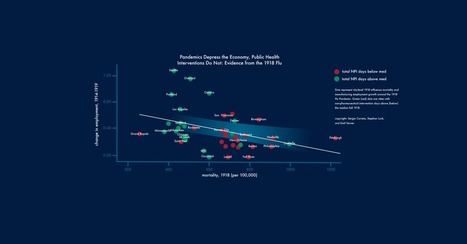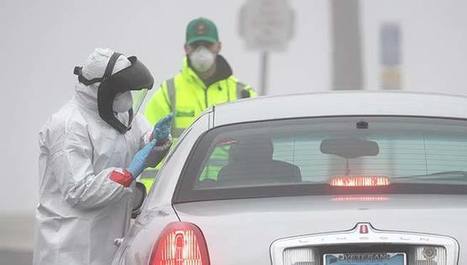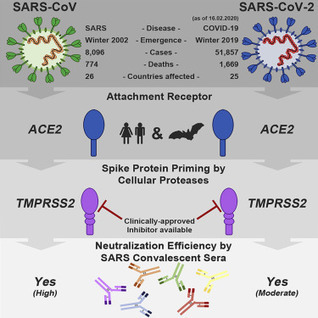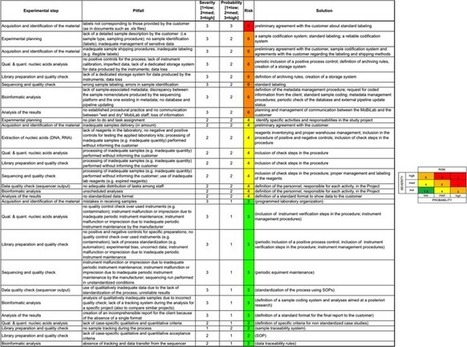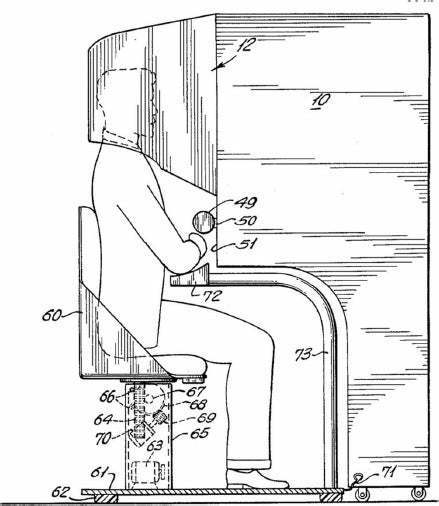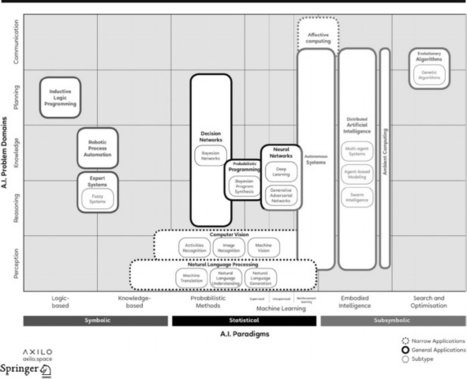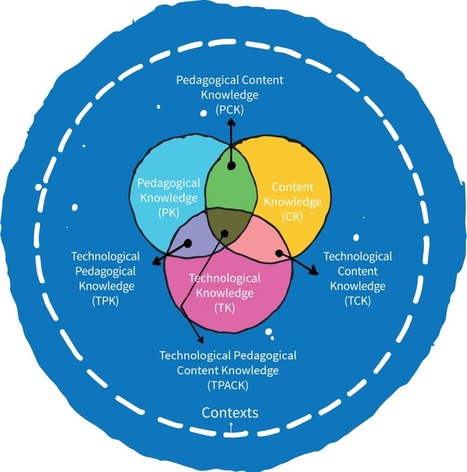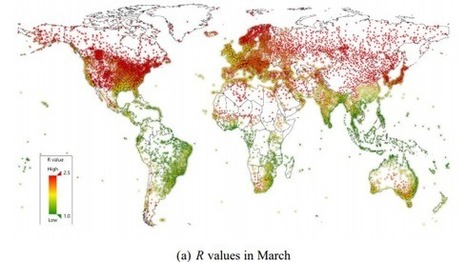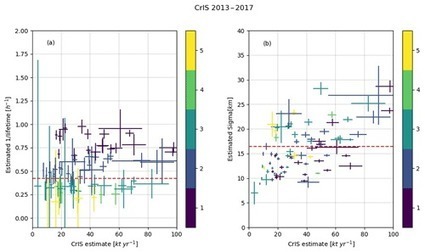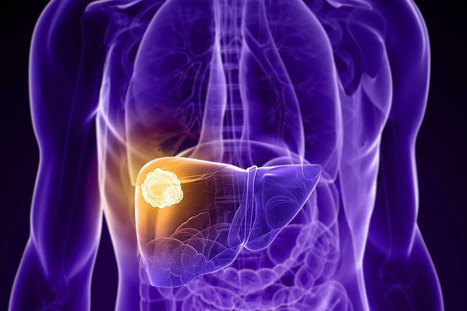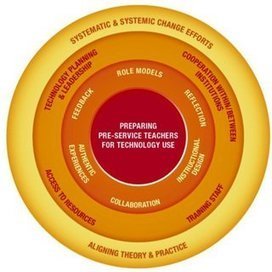 Your new post is loading...
A new modelling article, using data from Ontario, indicates that dynamic physical distancing and other measures could help maintain health system capacity and prevent intensive care units (ICUs) from becoming overwhelmed because of COVID-19, while allowing periodic psychological and economic breaks from restrictions.
Critics fear social distancing edicts hurt the economy, but research on the 1918 flu pandemic reveals an aggressive response can help spur economic recovery.
Amid the thousands of research publications on COVID-19, here are the ones we’re reading
Coronaviruses are a famous family of viruses that causes illness in human or animals. The new type of corona virus COVID-19 disease was firstly discovered in Wuhan-China. However, recently, the virus has been widely spread in most of the world countries and is reported as a pandemic. Further, nowadays, all the world countries are striving to control the coronavirus disease COVID-19. There are many mechanisms to detect the coronavirus disease COVID-19 including clinical analysis of chest CT scan images and blood test results. The confirmed COVID-19 patient manifests as fever, tiredness, and dry cough. Particularly, several techniques can be used to detect the initial results of the virus such as medical detection Kits. However, such devices are incurring huge cost and it takes time to install them and use. Therefore, in this paper, a new framework is proposed to detect coronavirus disease COVID-19 using onboard smartphone sensors. The proposal provides a low-cost solution, since most of the radiologists have already held smartphones for different daily-purposes. People can use the framework on their smartphones for the virus detection purpose.
The recent emergence of the novel, pathogenic SARS-coronavirus 2 (SARS-CoV-2) in China and its rapid national and international spread pose a global health emergency. Cell entry of coronaviruses depends on binding of the viral spike (S) proteins to cellular receptors and on S protein priming by host cell proteases. Unravelling which cellular factors are used by SARS-CoV-2 for entry might provide insights into viral transmission and reveal therapeutic targets. Here, we demonstrate that SARS-CoV-2 uses the SARS-CoV receptor ACE2 for entry and the serine protease TMPRSS2 for S protein priming. A TMPRSS2 inhibitor approved for clinical use blocked entry and might constitute a treatment option. Finally, we show that the sera from convalescent SARS patients cross-neutralized SARS-2-S-driven entry. Our results reveal important commonalities between SARS-CoV-2 and SARS-CoV infection and identify a potential target for antiviral intervention.
Management and research represent a binomial almost unknown, whose potentialities and requirements have not yet been fully exploited even if, recently, the scientific and social communities have felt the burden of producing results and data requiring at the same time reproducibility, reliability, safety and efficacy of the discoveries, as well as a profitable use of resources. A Quality Management System (QMS) could represent a valid tool for these purposes, improving the quality of the research. The research community could ask whether and how it is possible to apply this approach in a research laboratory without hindering their creativity, and what the possible benefits might be. On the other hand, an international standard for a quality management system appropriate for a research laboratory is yet to come. The choice, the design and the application of a QMS, inspired by the Good Laboratory Practices, in a research laboratory specialized on “omics” sciences, is fully described in this paper. Its application has already shown good outcomes as testified by specific metric of efficiency and effectiveness. The approach is innovative as there is no obvious requirement for research laboratories to develop and define quality objectives. The paper highlights how the QMS approach enhances the relationship with public and private sectors by increasing customer confidence and loyalty, as well as improving the overall performance of the laboratory in terms of throughput and value of research. These results encourage proposing it as a QMS model providing a new and scalable operational strategy to be applied in a research environment with the same target and even in a generic research laboratory.
Traumatic brain injury is heterogeneous, both in its induction and ensuing neurological sequelae. In this way, medical care depends on accurately identifying the severity of injury-related forces. Clinically, injury severity is determined by a combination of the Glasgow Coma Scale, length of unconsciousness, posttraumatic amnesia, and persistence of neurological sequelae. In the laboratory, injury severity is gauged by the biomechanical forces and the acute suppression of neurological reflexes. The present communication describes and validates the "fencing response" as an overt indicator of injury force magnitude and midbrain localization to aid in injury identification and classification.
Augmented reality (AR) is an emerging technology with the potential to transform learning. By digitally adding or removing information from the physical world, AR creates a sense that real and virtual objects coexist, and can enhance people's interactions both with each other and with objects in the world. Most museum implementations of AR have been in the realms of art and history. Using examples from across formal and informal settings, this article illustrates the learning affordances of AR for museums that aim to communicate concepts related to human health. These topics often present spatiotemporal challenges for learning, but can be made more accessible to learners when contextualized within personally, socially, and culturally relevant contexts. After briefly reviewing research on learning with AR, the article examines how museum designers might leverage AR's capacity for spatial and temporal representation, narrative and interactivity, real-time personalized scaffolds, and collaboration, to create meaningful learning experiences on medicine and human biology. The article ends with a discussion of issues related to the use of AR in museums, and thoughts on future research.
Artificial intelligence (AI) has dominated recent headlines, with its promises, challenges, risks, successes, and failures. What is its foreseeable future?
Objectives Informed decisions about cancer screening require accurate knowledge regarding cancer risks and screening. This study investigates: (1) European women’s knowledge of their risk of developing breast, ovarian, cervical or endometrial cancer, (2) their knowledge about mammography screening and (3) whether an evidence-based leaflet improves their knowledge.
Through its important role in the formation of particulate matter, atmospheric ammonia affects air quality and has implications for human health and life expectancy1,2. Excess ammonia in the environment also contributes to the acidification and eutrophication of ecosystems3,4,5 and to climate change6. Anthropogenic emissions dominate natural ones and mostly originate from agricultural, domestic and industrial activities7. However, the total ammonia budget and the attribution of emissions to specific sources remain highly uncertain across different spatial scales7,8,9. Here we identify, categorize and quantify the world’s ammonia emission hotspots using a high-resolution map of atmospheric ammonia obtained from almost a decade of daily IASI satellite observations. We report 248 hotspots with diameters smaller than 50 kilometres, which we associate with either a single point source or a cluster of agricultural and industrial point sources—with the exception of one hotspot, which can be traced back to a natural source.
In 2012 (N = 2339) and 2015 (N = 1327), a longitudinal analysis was carried out to investigate changes in the media usage patterns of German higher education (HE) students, with a special emphasis on differences between traditional students (TS) and non-traditional students (NTS). Based on an online questionnaire, the students provided information about the digital devices they own or have access to, on the frequency of use as well as perceived value of digital media, e-learning tools and services for their learning in HE. The presented results indicate implications for the instructional design of teaching and learning in HE.
The ubiquitous nature of technology in the world has not yet translated into the ubiquitous use of technology to transform learning and teaching. Teachers lack the confidence and competence to integrate technology across a broad range of tools within a range of contexts. Technological pedagogical content knowledge (TPACK) has become a common framework to explore technology within teaching and teacher education. However, little research exists to explore the similarities and differences of TPACK between different teacher education programmes, within different countries or even different disciplines, especially in a secondary context. Using a self‐report online survey, this study sought to compare and contrast TPACK results from pre‐service teachers studying in secondary teacher education programmes in Australia and Israel. Findings suggest that TPACK is higher in Australia, and in both countries for those students who were aged over 26. There were no significant differences between gender and disciplines reported. The paper also discusses broad‐scale implications for the future of research in TPACK.
|
The news that UM medical researchers have been testing the possibility that N95 Personal Protection Equipment (PPE) masks can be reused has attracted attention from far and wide.
'The killer coronavirus probably originated from a laboratory in Wuhan,' the Chinese researchers state.
A new research paper ties temperature and humidity directly to coronavirus transmission rates.
The data set aims to accelerate scientific research that could fight the Covid-19 pandemic.
Let's take inventory on the therapies that are being developed for the coronavirus epidemic. Here is a very thorough list of at Biocentury, and I should note that (like Stat and several other organizations) they're making all their Covid-19 content free to all readers during this crisis.
Ammonia (NH3) is an essential reactive nitrogen species in the biosphere and through its use in agriculture in the form of fertilizer (important for sustaining humankind). The current emission levels, however, are up to 4 times higher than in the previous century and continue to grow with uncertain consequences to human health and the environment. While NH3 at its current levels is a hazard to environmental and human health, the atmospheric budget is still highly uncertain, which is a product of an overall lack of measurements. The capability to measure NH3 with satellites has opened up new ways to study the atmospheric NH3 budget. In this study, we present the first estimates of NH3 emissions, lifetimes and plume widths from large (>∼5 kt yr−1) agricultural and industrial point sources from Cross-track Infrared Sounder (CrIS) satellite observations across the globe with a consistent methodology. The same methodology is also applied to the Infrared Atmospheric Sounding Interferometer (IASI) (A and B) satellite observations, and we show that the satellites typically provide comparable results that are within the uncertainty of the estimates.
We performed the first proteogenomic characterization of hepatitis B virus (HBV)-related hepatocellular carcinoma (HCC) using paired tumor and adjacent liver tissues from 159 patients. Integrated proteogenomic analyses revealed consistency and discordance among multi-omics, activation status of key signaling pathways, and liver-specific metabolic reprogramming in HBV-related HCC. Proteomic profiling identified three subgroups associated with clinical and molecular attributes including patient survival, tumor thrombus, genetic profile, and the liver-specific proteome. These proteomic subgroups have distinct features in metabolic reprogramming, microenvironment dysregulation, cell proliferation, and potential therapeutics. Two prognostic biomarkers, PYCR2 and ADH1A, related to proteomic subgrouping and involved in HCC metabolic reprogramming, were identified. CTNNB1 and TP53 mutation-associated signaling and metabolic profiles were revealed, among which mutated CTNNB1-associated ALDOA phosphorylation was validated to promote glycolysis and cell proliferation. Our study provides a valuable resource that significantly expands the knowledge of HBV-related HCC and may eventually benefit clinical practice.
The main purpose of this article is to investigate the impact of teacher’s position on students’ performance in higher education. A new pedagogical approach based on collaborative learning is used due to the design of a smart learning environment (SLE). This workspace uses, respectively, information and communication technologies (ICT) and radio frequency identification (RFID)-based indoor positioning system in order to examine students’ perceptions and the involvement of groups into this smart classroom.
Traditional surveillance systems produce estimates of influenza-like illness (ILI) incidence rates, but with 1- to 3-week delay. Accurate real-time monitoring systems for influenza outbreaks could be useful for making public health decisions. Several studies have investigated the possibility of using internet users' activity data and different statistical models to predict influenza epidemics in near real time. However, very few studies have investigated hospital big data. Here, we compared internet and electronic health records (EHRs) data and different statistical models to identify the best approach (data type and statistical model) for ILI estimates in real time.
The defense of body temperature against environmental thermal challenges is a core objective of homeostatic regulation governed by the autonomic nervous system. Autonomous mechanisms of thermoregulation are only weakly affected by top-down modulation, allowing only transient tolerance for extreme cold. There is however, anecdotal evidence of a unique set of individuals known for extreme cold tolerance. Here we present a case study of a 57-year old Dutch national, Wim Hof, the so-called "Iceman", with the ability to withstand frequent prolonged periods of extreme cold exposure based on the practice of a self-developed technique involving a combination of forced breathing, cold exposure and meditation (collectively referred to as the Wim Hof Method, henceforth "WHM").
Most studies on traditional asynchronous online discussion suggest that facilitating dialogue, that is,commenting forum activities, result in better learning and performance. However, due to open entry and diverse learner backgrounds, learner behaviour inmassive open online courses (MOOCs) may be different. Viewing forum messages, which involvesfewer mental and physical actions as well as less cognitive processing, rather than posting forum massages, might better match the learner’sstudypurpose. In this study, we investigated the effects of three common types of online MOOC discussion forum activities (viewing, voting and commenting) on student peer learning (peer reviews) and performance (quiz scores). We used stepwise regression models to analyse two data samples of a humanity andart MOOC provided by a private university in the United States for exploring factors influencing peer learning and performance. The results indicate that peer learning and performance were primarily predicted by viewing, and to a lesser extent by commenting. The three plausible explanations for the findings are the learner’sstudy purpose, weaker instructor-learner ties, and voluntary forumparticipation. We suggest ways to encourage viewing messages in forumsand presentlimitations and further directions.
The main aim of this conceptual paper is to provide an overview of effective strategies to support pre-service teachers to adequately integrate ICT in teaching and learning activities. Specifically, the focus is on the strategies included in the SQD (Synthesis of Qualitative Evidence) model: 1) using teacher educators as role models, 2) reflecting on the role of technology in education, 3) learning how to use technology by design, 4) collaboration with peers, 5) scaffolding authentic technology experiences, and 6) providing continuous feedback. To turn this model into practice, the approach of teacher design teams is adopted.
|
 Your new post is loading...
Your new post is loading...






